African violets are popular houseplants that come with a cluster of beautiful flowers. They bloom throughout the year, but sometimes your African violets may not bloom at all.
So, in this article, we will discuss why is your African violet not blooming?
African violets won’t bloom if they are kept under low lighting conditions, inappropriate temperature range or their nutrient requirements are not met. To ensure healthy blooming, fertilize your African violet and move them to a spot where it gets bright indirect light and 65-80°F temperature.
An African violet that isn’t blooming could mean that their basic needs are not met. Several cultural issues can discourage your African violets from blooming.
Your African violets will bloom again if you provide them with the proper care. This article will explain the common causes that don’t let your plants bloom and how you can fix them to make your African violets bloom again.
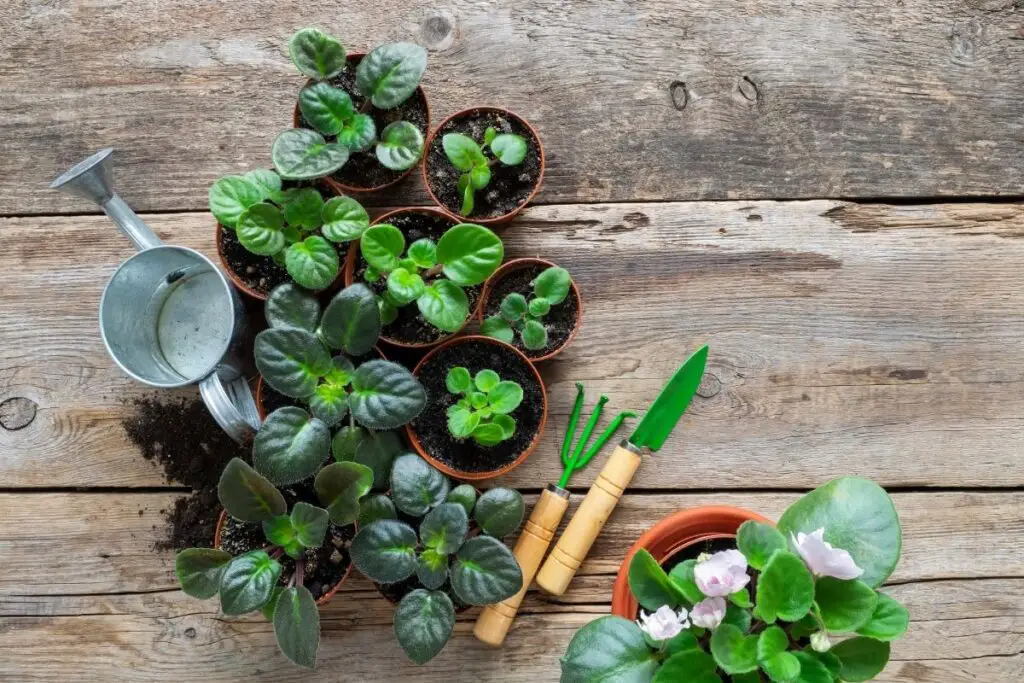
How often do African violets bloom?
African violets can bloom nearly year-round with the proper care. Each healthy bloom of this plant will last for two to three weeks.
African violets can continue to produce new blooms regularly for 10 to 12 months out of the year. These plants are known for being fussy about their care and needs. If you do not provide them with the right care, they will stop blooming.
Why have African violets stopped blooming?
African violets are known for being fussy about their care and needs. They will withhold their beautiful blooms even if just one of their fundamental needs is not met.
Luckily most of the needs that make your plant stop flowering are easy to remedy.
We will now discuss the problems that don’t let your African violets bloom and how to cure these problems.
The common reasons behind no blooming of African violets are:
- Inadequate sunlight exposure
- Inappropriate temperatures
- Improper watering
- Lack of humidity
- Poor fertilization
- Wrong soil
- Wrong pot size
- Pests and diseases
We will discuss each point in detail.
Inadequate sunlight exposure
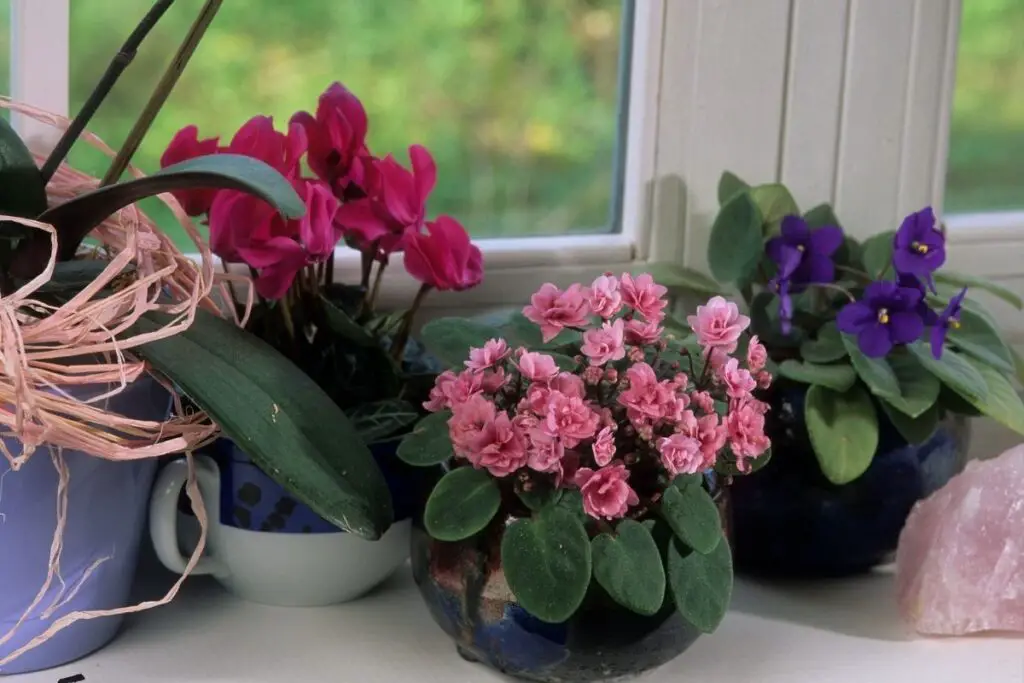
Indirect light is most suitable for your African violets. These plants appreciate living in a sunny area where they won’t be exposed to direct sunlight or excess heat.
Low light will not allow them to bloom. Poor light will force the African violets to stretch towards the light more and produce fewer or no blooms.
Thus, the plants will have thin and long stems with tiny leaves and become leggy due to poor light.
In contrast, excess light will cause sunburn in your African violets, and you will notice scorched leaves.
Solution
- Provide your African violets 8 hours of bright indirect light every day. They will also need 8 hours of darkness every night.
- If you are growing them indoors, in the summer, place your African violets in the north-facing window or somewhere they get protection from the sun’s harsh rays.
- In winters, place them near an east-facing window that will provide your plant with sufficient light without the risk of sunburn.
- Keep them away from cold and rotate the pot once a week so that all the leaves receive light.
- You can opt for artificial light for about 12-14 hours a day to fulfill their light requirements.
- While growing them in your garden, try to find a spot that has some shade to filter the direct sunlight. Bigger trees can help do so.
Also read: What Kind Of Light Does An African Violet Need? (African Violet Light Requirements)
Looking for gardening supplies? We have tested 100's of products before recommending them to you guys. Check out our best pick below:
| Image | Gardening Supplies | Best Price? |
|---|---|---|
 Top
Top Top
Top | Raised Garden Bed Kit | Check On Amazon |
 | XLUX Soil Moisture Meter, Plant Water Monitor, Soil Hygrometer Sensor for Gardening, Farming, Indoor and Outdoor Plants, No Batteries Required | No Results |
 Top
Top Top
Top | 82 Pcs Garden Tools Set and Extra Succulent Tools Set | Check On Amazon |
 | Joeys Garden Expandable Garden Hose with 8 Function Hose Nozzle, Lightweight Anti-Kink Flexible Garden Hoses, Extra Strength Fabric with Double Latex Core, (50 FT, Black) | No Results |
 Top
Top Top
Top | Dual Chamber Compost Tumbler | Check On Amazon |
 Top
Top Top
Top | Sunnyglade Plant Stakes | Check On Amazon |
 Top
Top Top
Top | Organic Cold Pressed Neem Seed Oil | Check On Amazon |
 Top
Top Top
Top | Mighty Mint Gallon :-Insect and Pest Control Peppermint Oil | Check On Amazon |
 Top
Top Top
Top | Scotts DiseaseEx Lawn Fungicide | Check On Amazon |
 Top
Top Top
Top | Jacks Classic 20-20-20 All Purpose Fertilizer | Check On Amazon |
 Top
Top Top
Top | 30,000 Seeds Pollinator Attracting Wildflower Mixture | Check On Amazon |
 Top
Top Top
Top | Survival Vegetable Seeds Garden Kit-Over 16,000 Seeds | Check On Amazon |
Inappropriate temperatures
African violets are tropical plants that require warm temperatures to thrive and bloom. Excessive hot and cold temperatures can prevent African violets from blooming.
If they grow in high temperatures, they stop flowering, and low temperatures cause stunted growth in the plants.
If they are grown as indoor plants, it’s not hard to regulate the temperatures.
Solution
- Ensure that the daytime temperature is around 70-80°F (21-27°C) and night temperatures are around 65-70 °F (18-21 °C).
- In winter, remove your African violets from windowsills at night or place a sheet or blanket over them if they are in the garden to protect them from low temperatures.
Improper watering
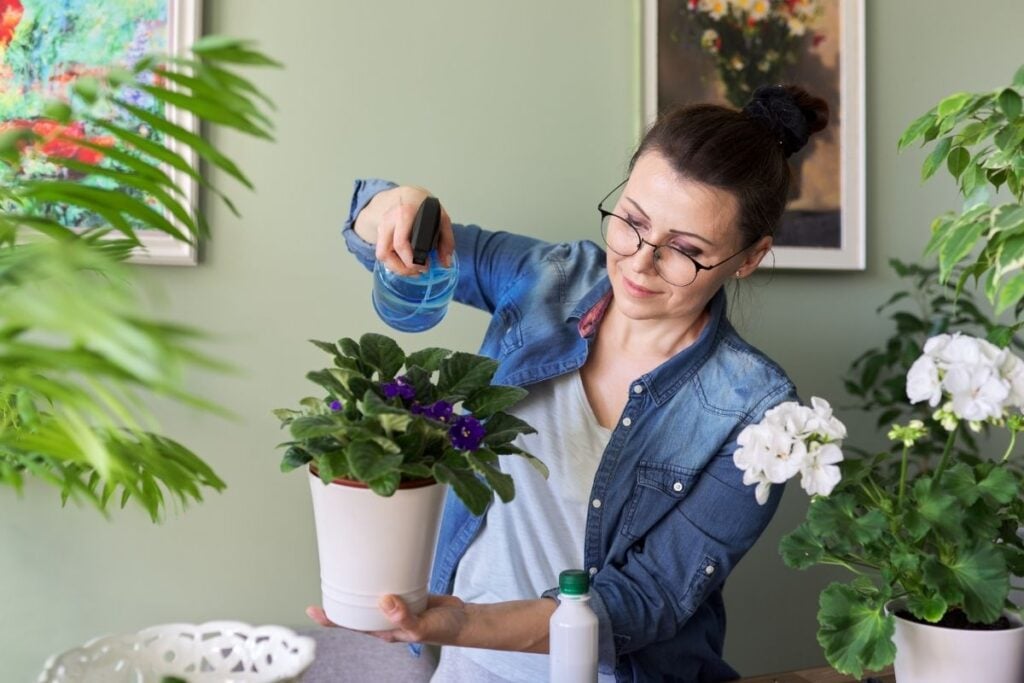
African violets like to stay in evenly moist soil and not get completely dry between waterings. They also do not prefer to stand in water. Too much water can create root rot issues in African violets.
Underwatering will cause the roots to die if the soil becomes hard. The plant will also wilt, and the flowers will drop off.
Both under-watering and overwatering will damage the root systems, and the plant will sacrifice its flowers to survive.
Solution
- Always plant your African violets in a pot with proper drainage holes to drain the excess water.
- For proper watering, you can water the soil mix from above by using a watering can with a narrow spout and ensure that the water doesn’t fall on the leaves. Then rotate the pot to ensure water reaches all parts of the soil.
- Another good technique to water your plant is by using the saucer method. Place the pot in a container filled with 1-inch water. Then allow the plant to sit for about 30 minutes and then pour off the excess water.
- Water regularly for keeping the soil moist but never saturated.
- Make sure to use well-draining soil in the garden bed or in the pot that will not hold a lot of water.
Also read: How Often Should African Violets Be Watered? (African Violet Water Requirements)
Lack of humidity
Humidity is an essential aspect of growing African violets. They will grow and flower best in high humidity. Usually, these plants need humidity levels of at least above 55%.
Low humidity will lead to old, wrinkled-looking leaves, and the plant will stop blooming.
Solution
- You can group many plants to increase the humidity level around them. Just don’t let the plants touch each other as this can spread pests and diseases.
- You can place your African violets pot on a tray of pebbles and water. When the water evaporates from the tray, the excess moisture will produce humid air around the plant.
- You can install a humidifier to increase the humidity level around the plants.
- You can use a clay pot to grow your plants. Clay pot retains moisture and releases it as humidity around plants.
- When growing in the garden, you can place containers filled with water around the plant. When the water evaporates, the humidity level will increase.
- You can put plastic sheets on the plants to create a greenhouse that will trap the moisture.
Also read: Do African Violets Like Misting? (+Humidity Guide)
Poor fertilization
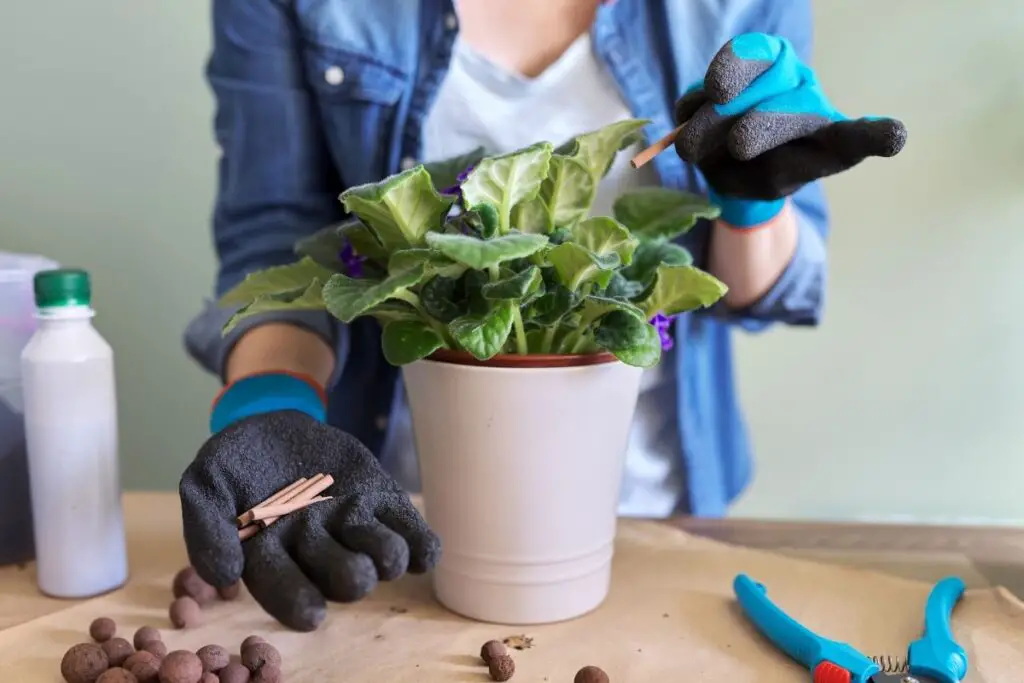
The blooming of African violets depends on good fertilization practice. They need sufficient nutrition as they will require lots of energy to produce buds and flowers.
If we don’t fertilize them on a timely basis, they will not have the necessary nutrients, which helps them to produce blooms.
On the other hand, overfertilization will increase the nitrogen level in plants, and thus the plant will have more foliage at the expense of flowers.
Too much fertilization can even burn and kill the plant.
Solution
- Buy fertilizers specifically for African violets. Use a balanced fertilizer that contains all the major plant nutrients like phosphorus, nitrogen, and potassium.
- Fertilize your plants with water-soluble fertilizers with a 20:20:20 or 12:36:14 ratio. Add ½ teaspoon fertilizer per gallon of water.
- Follow the instructions given in the label of fertilizers but dose only half the recommended dosage.
- Fertilize them every 2- 4 weeks in spring, summer, and fall.
Also read: What Kind Of Fertilizer Is Good For African Violets? (+Best Picks)
Wrong soil
African violets prefer a porous, fertile, and well-draining soil mix, and the plant will struggle to bloom if the soil mix is too dense for them.
A heavy soil mix will restrict airflow in the soil and also cause poor drainage. The soil pH levels also determine the blooming. Generally, African violets prefer slightly acidic soil with a pH value of 5.8 and 6.2.
If the soil pH level is too high or too low, the plants will not absorb nutrients properly from the soil, and therefore will struggle to bloom.
Solution
- Use a light, loose, humus-rich, and well-draining potting mix for African violets.
- You can use a commercial potting mix, a mixture of vermiculite and perlite that creates air pockets in the soil and promotes healthy roots.
- You can measure the soil pH level to understand the pH level by using a soil testing kit.
Also read: What Kind Of Soil Is Best For African Violets? (+Best Soil Mix)
Wrong pot size
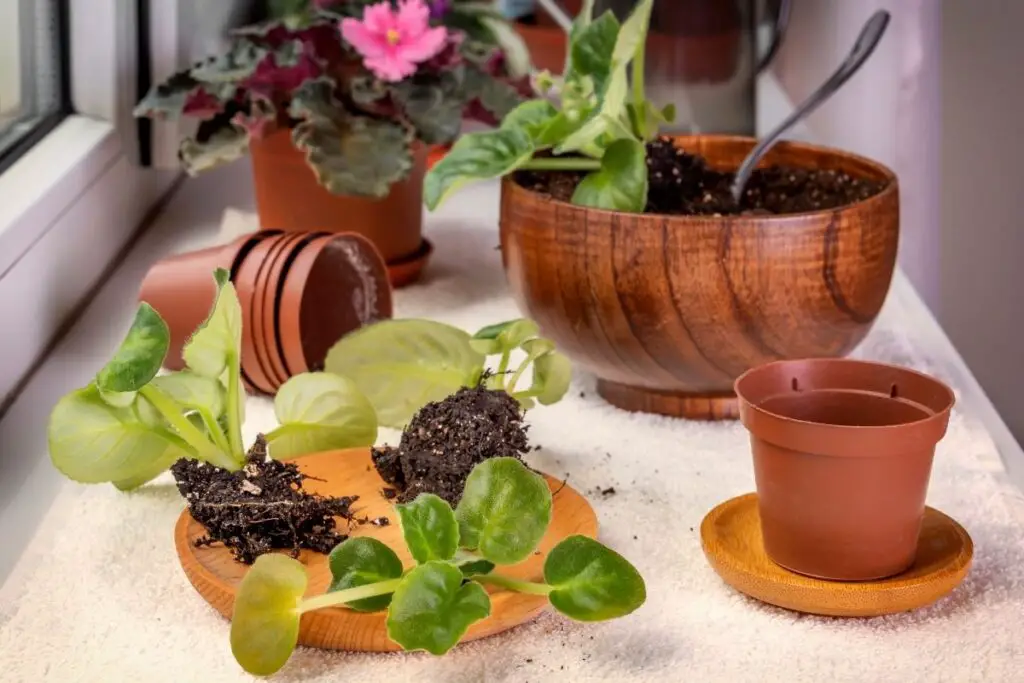
If you are growing African violets indoors, a wrong-sized pot could be the reason behind delayed flowering in African violets. These plants do not like large pots, and they prefer to be root bound in small areas.
It is always good to refresh the soil and repot them to a new pot. But repotting to a big pot will not let them bloom.
They like to sit in smaller pots, but sometimes too small pots can also create overcrowding issues. The plant will have extra crowns, suckers, and strange leaf formation.
This extra growth will drain out the energy from the plant that they could have used to produce blooms.
Solution
- Never plant your African violets into a pot that is way bigger than the plant.
- You can repot the plant into the same pot after cleaning the pot and using a fresh soil mix.
- You can use both clay and plastic pots but ensure that the pots have a sound drainage system.
- You can propagate the offshoots of African violets into separate pots or trim off the extra growth of the plants that prevent blooming.
Also read: What Kind Of Pot Does An African Violet Need? (Pot Type+Size)
Pests and diseases
Your plants may not have enough energy to produce new blooms if they are busy fighting outside obstacles like pests and diseases. Pests and diseases will make your plant sick by feeding on its roots, foliage, and flowers.
The leaves of the African violets will become spotted, speckled, or yellow when insects are present on them. Some common pests of African violets are Mealybugs, powdery mildew, blossom blight, etc.
The plant affected by pests and diseases may even die if they are not cured on time.
Solution
- You should always check for symptoms of infestation during the watering and grooming of violets.
- To remove pests, you can add a few drops of insecticidal soap to water and wash your plants.
- Spray pesticides and insecticides to kill and remove pests from your plants.
- You can use home remedies such as neem oil or horticultural oil to remove the pests.
- Wipe the bugs with a cotton ball dipped in an alcohol solution.
- Prune the infected parts of plants such as the infected leaves and stems.
- Avoid overwatering your plants and reduce the humidity level around the plant if infected with grey mold.
Also read: How To Get Rid Of Bugs On African Violets? (Signs+Treatment)
Final thoughts
African violets can bloom nearly year-round with the proper care. An African violet that’s not blooming could mean that their basic needs are not met.
To make your African violets bloom correctly, give them the right amount of light, water, fertilizer, and make sure that the temperature is optimal and the plant is potted correctly.
When all the requirements are provided, African violets will be healthy and happy again and surprise you with many beautiful flowers.
Source: Wikipedia, African violet: Classical breeding, African Violet Society of America, In vitro propagation of African violet, University of Florida, North Dakota State University, The University of Georgia.
